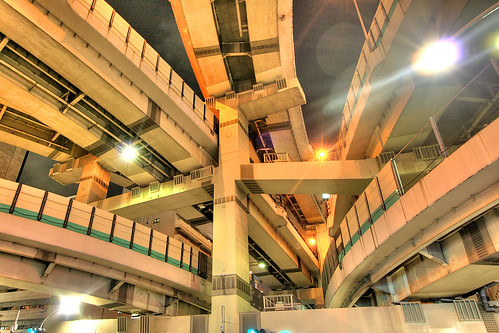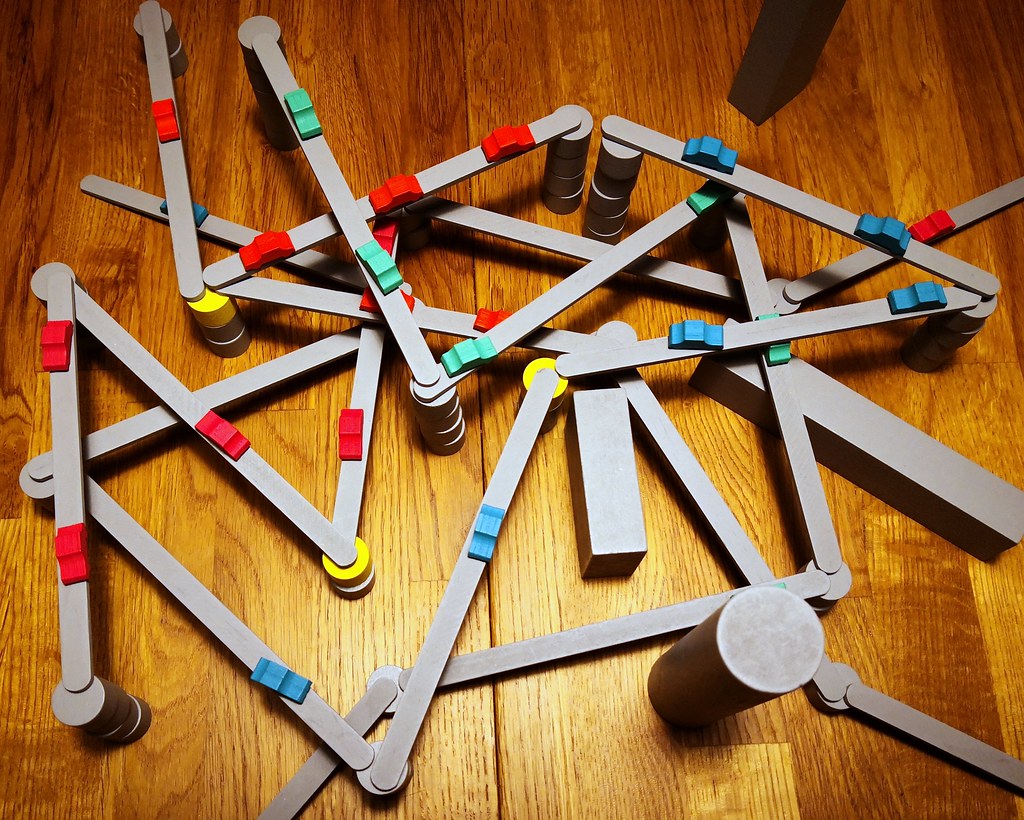| Strategy | Luck |
|---|---|
| Interaction | Components & Design |
| Complexity | Score |

You’ve probably seen photos of the crazy highways of Tokyo, with loops of the Shuto Expressway criss-crossing with on-ramps, off-ramps, sideways-ramps and itself in multiple levels. (Not going through any buildings, though. The Gate Tower Building is in Osaka.) The Expressway turned out that way, at least in parts, because of the 1964 Olympic Games. The first bit of Shuto Expressway was opened in 1962, and for the Olympic Games Tokyo wanted to present an efficient, modern transport system. Building this way was the cheap and quick way to have the Expressway connect much of the city.
It’s obvious that there’s a game hidden in that story. Many designers could have done it, had they thought of it. Resource management, worker placement, a tight time limit, contract cards to connect certain neighborhoods… . But many designers didn’t think of it. Naotaka Shimamoto and Yoshiaki Tomioka did, and they made a very different game called Tokyo Highway.
The On-ramp – How to play Tokyo Highway
Tokyo Highway became a tactical dexterity game. Sounds weird, but that’s the best way to describe it. Players only have three kinds of components: Flat cylinders as support pillar segments, long popsicle sticks for the highways, and cars in player colors as marks of ownership.

Players start with an on-ramp in play, a street segment from the table up to a single pillar segment. A turn is quick and simple, at least in theory. First, you build a pillar of any number of segments, then you place a highway stick from that pillar to the previous pillar you built.
Always having to build a new pillar makes it impossible to build circles already. Beyond that there are only two restriction in how you build. One, your highway may not cross a pillar. It can and should cross other highway segments, but never a pillar. Two, the new pillar has to be exactly one segment higher or lower than the previous pillar. Straight is too boring.
That leaves the cars. One of them is on your on-ramp, marking where your highway begins. The goal is to be the first player to place all your cars, so how you get the remaining ones into play is somewhat relevant. You may place a car on your newly build highway for every opponent’s highway below yours that doesn’t have other highways above it, and for every opponent’s highway above yours that doesn’t have other highways below it. Or, in simpler terms, when your highway is the first to go above or below an opponent’s highway, you place a car. You can place any number of cars in one turn – if your opponents give you the opportunity.

One special case when building highways are the yellow intersection blocks. You start with two of them (three in a two-player game) and if you top your pillar with one of them you get two awesome benefits. The pillar may have any height, so you can build steeper highways or even straight highways. Even better, on a later turn you may start your new piece of highway from there instead of your last pillar, creating a three-way fork.
That’s almost all there is to say about the rules of Tokyo Highway. One last thing is how the game ends. One way, as mentioned above, is for a player to place their last car and win immediately. The other way is for all but one players to run out of pieces, then the only remaining player wins. The obvious way to run out of pieces before everyone else is to build higher pillars and run out of pillar segments. The more entertaining way it to pay penalties to other players because you knocked over their highway.
How to stop playing Tokyo Highway – Our Verdict
Short answer: You don’t stop playing Tokyo Highway. It’s too much fun, even if you’re not usually into dexterity games. It does a good way of easing you into the whole dexterity thing, anyway. Your first one or two moves are trivial, just going upwards from your on ramp. Then the highways start crossing, and suddenly putting a pillar in the middle of that knot already on the table is rather challenging, after all.

That is part of the tactics in “tactical dexterity game”, too. When you start playing you’re only looking for opportunities to score. Then you start planning ahead to deny your opponents scoring opportunities. The real fun starts in stage three, when you intentionally offer a chance to score big points but with a high risk of bringing the whole game down. And then watch them sweat. Planning ahead is a much bigger part of Tokyo Highway than it is of most dexterity games. Fortunately, the game is simple enough that even the worst overthinker can’t slow it down too much. Well, unless they knock everything over and now have to rebuild the whole highway as well as they can.
Finally, don’t be fooled by Tokyo Highway‘s minimalist components. Grey wood cylinders and popsicle sticks may not look like much, but the resulting tangle of highways with colorful cars in the middle is one of the prettiest game end results ever.
Tokyo Highway is so much better than any economic game about building the Shuto Expressway could ever have been.











